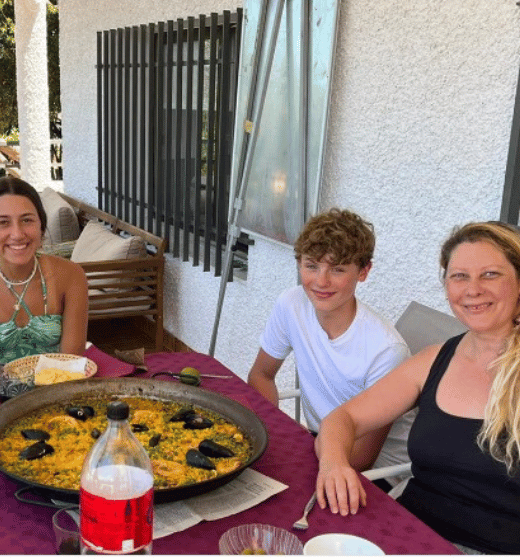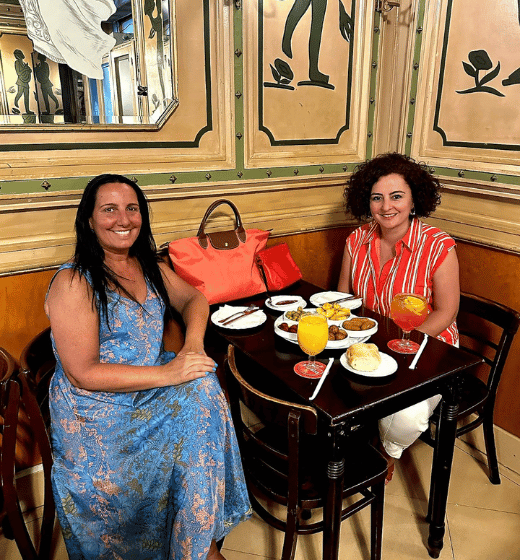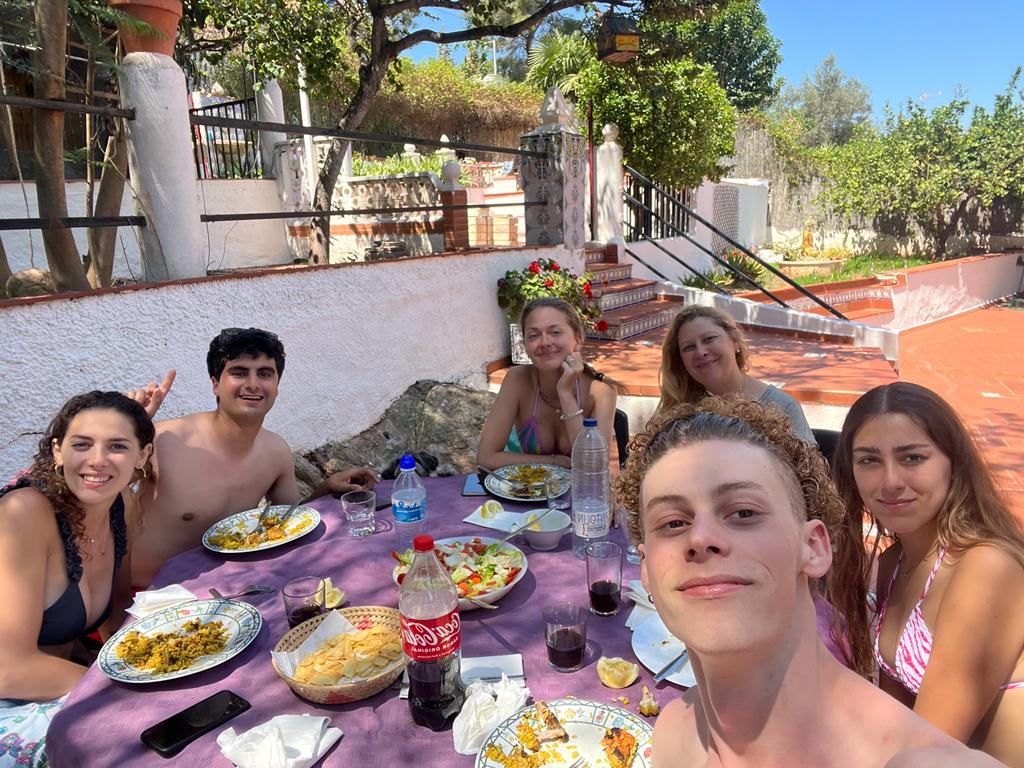

If you’re learning Spanish, you might have searched for Spanish food online, like the famous Spanish tortilla or the classic paella Valenciana. We get why! Food is a big part of learning a new language and its culture.
Sometimes, looking up dishes, maybe a cold tomato soup or seafood dishes from Southern Spain, makes you more curious. That’s totally okay.
Spanish and Latin American meals, with their rich tomato sauce or the unique cured ham, often have special names.
If names of dishes, from tapas bar favorites to a main dish like tortilla Española, have made you wonder, Spanish Express is here to help.
Here’s your chance to learn new words and get why Spanish food, maybe even a rice dish or something with green peppers, is so loved. Maybe you’ll cook something like pan con tomate or find out about other dishes from Spanish-speaking places.
Let’s start exploring food!
Spanish Food From Barcelona
Here are some of the delicacies you must taste to understand Spanish food and culture in Barcelona. Don’t worry, I will not leave you alone in this task. Our host teachers in Barcelona will help you savor all these dishes on your next SHIP with Spanish Express.
You will not only enjoy the food but will cook some of these dishes together with our host teachers and their families and friends. So, gastronomy becomes a tool to learn Spanish when you do it with Spanish Express.
1. Fideuà
Fideuà is like a sea gift. It’s made with noodles and fresh seafood. People in coastal areas make it a lot. It’s a twist on the famous paella.
Instead of rice, they use noodles. It started in Valencia but Barcelona loves it too. It’s a must-try for those who love the sea’s flavors.
This dish shows how Spanish cooks use what’s around them to make something new and tasty.
2. Arros negre
Arros negre means “black rice” in English. It gets its dark color from squid ink. The main parts are rice, squid ink, and seafood.
It’s a traditional dish in Barcelona. People often eat it with a side of aioli sauce. This sauce is garlic and goes well with the rich taste of the rice.
Arros negre is a great way to see how Barcelona uses local seafood in its cooking.
3. Botifarra amb mongetes
This dish is simple but full of taste. It has botifarra sausage and green beans. Botifarra is a kind of pork sausage from Catalonia.
The beans cooked with the sausage soak up its flavors. It’s a traditional dish that shows the simple beauty of Catalan cooking.
Families in Barcelona have loved it for years. It’s a warm, comforting meal that’s perfect for any day.
4. Escudella i Carn d’Olla / Sopa de Galets
Escudella i Carn d’Olla is a hearty winter stew. It combines meat, beans, and vegetables. Sopa de Galets uses these same ingredients but adds pasta shells.
It’s a traditional dish for cold days. Families in Barcelona and all over Catalonia make it a lot during the winter.
This stew is full of flavors from Spanish chorizo, ham, and sometimes even roast lamb. It’s a perfect example of traditional Spanish dishes that warm you up and bring people together.
5. Pa amb tomàquet
Pa amb tomàquet is simple but a favorite. It’s bread with tomato rubbed over it, then drizzled with hot olive oil and a pinch of salt.
Sometimes, garlic is added. It’s a tapas dish you’ll find in every Spanish restaurant in Barcelona. This dish shows how simple ingredients can make something absolutely delicious.
It’s often eaten with Spanish ham or cheese. Pa amb tomàquet is a staple in Spanish meals and reflects the love for fresh, straightforward flavors.
6. Calçots
Calçots are a type of green onion from Catalonia. They are typically served grilled and dipped in Romesco sauce, a mix of nuts, roasted vegetables, and Spanish paprika.
Eating calçots is a social event in Barcelona and nearby areas, known as “Calçotadas“. These gatherings happen from January to April.
Calçots are not just food; they’re a reason for friends and family to come together. The experience of peeling the charred outside to get to the soft, sweet inside is as enjoyable as the taste.
Spanish Dishes From Valencia
Pilar is a host teacher in Valencia, known for her expertise in making Paella, the region’s famous dish. Students have the opportunity to live with Pilar, engaging in cooking sessions and enjoying meals together.
This setup offers a unique chance to learn about the local culture and culinary traditions.
7. Paella
Paella is a famous dish from Valencia. It’s known all over the world. This dish has rice, saffron, and different kinds of meat or seafood.
Sometimes, you can find green beans and a hint of smoked paprika in it. Paella shows how Spanish cuisine can mix local ingredients to create something special.
People in Valencia often eat paella with family and friends. It’s a symbol of Spanish food and brings people together to enjoy a meal.
8. Esgarret
Esgarret is a unique dish from Valencia. It’s made with roasted peppers and salted cod. Often, it has roasted garlic and olive oil added for extra taste.
This dish is a good example of traditional dishes from the region. Esgarret is usually served cold and is perfect for hot days.
It’s light but full of flavors. This dish is less known outside of Valencia but is a favorite in local Spanish restaurants.
9. Fartons
Fartons are sweet bread from Valencia. They are long and soft. People typically dip them in horchata, a drink made from tiger nuts.
This combination is popular in the summer. Fartons show the sweet side of Valencian cuisine. Making them involves dough, sugar, and a bit of white wine to add a special touch.
They are not just a treat; they’re part of Valencia’s tradition and bring a sweet end to any meal.
10. Horchata
Horchata is a refreshing drink from Valencia, made from tiger nuts. It is sweet and served cold, perfect for hot days.
Unlike anything you might have tried, this drink is unique to Valencia. It’s often enjoyed with fartons, a type of sweet, fluffy pastry.
Horchata is not just a drink; it’s part of Valencia’s culture. People of all ages love it. This beverage shows the variety of Spanish drinks, offering a non-alcoholic choice that’s loved by everyone.
11. Turrón
Turrón is a sweet treat that comes from Spain. It’s very popular during Christmas. This candy is made from almonds, honey, sugar, and egg white.
There are many types of turrón, but the ones from Valencia are well-known. Some are hard and crunchy, while others are soft and chewy.
Turrón shows the sweet side of Spanish cooking. It’s a classic Spanish dish that has been loved for many years. Eating turrón is a tradition in many Spanish homes during the holidays.
12. Oranges
Valencia is famous for its oranges. These are some of the best in the world. Valencia’s oranges are juicy and sweet. They are used in many dishes, from salads to desserts.
Oranges from Valencia show the region’s rich soil and sunny weather. They are not just eaten fresh but also used to make juice and other products.
The orange is a symbol of Valencia and is loved by people all over Spain. It adds a fresh taste to many Spanish meals.
13. Crema Catalana
Crema Catalana is a famous dessert from Catalonia, yet it’s enjoyed all over Spain, including Valencia.
This custard dessert is similar to the French crème brûlée but has a Spanish twist with a hint of lemon zest and cinnamon.
The top is caramelized sugar that cracks when you tap it with a spoon. Crema Catalana is a traditional recipe often served on Saint Joseph’s Day, but it’s loved year-round.
It shows the blend of Spanish cooking with other influences, creating a dessert that is both familiar and uniquely Spanish.
14. Sweet potato cake
Sweet potato cake is a less common but delightful dish in Valencia. Made from sweet potatoes, this cake is moist, sweet, and often spiced with cinnamon.
It’s a traditional recipe that showcases the region’s love for using fresh, local ingredients in unexpected ways. It might be found in some homes and local bakeries rather than the typical tapas bars.
This cake represents the variety of Spanish desserts, going beyond the famous Spanish churros and offering a unique taste that’s rooted in the agricultural wealth of Valencia.
Spanish Cuisine From Burgos
In Burgos, you live with host teachers and learn Spanish by cooking and eating Spanish foods.
Our teachers make the given Spanish cuisine itself and share it with their students. With Spanish Express, you learn by doing and speaking, making it a natural and fun experience.
15. Morcilla de Burgos
Morcilla de Burgos is a type of blood sausage that’s unique to the Burgos region. It’s made with rice, onions, and spices, all mixed with pig’s blood.
This dish is a key part of the tapas menu in local bars and is famous for its rich, deep flavor. Morcilla de Burgos shows how Burgos uses traditional recipes to make food that stands out.
It’s often fried in olive oil and served with crusty bread. This sausage is a classic Spanish dish that reflects the strong, rustic flavors preferred in the region.
16. Queso de Burgos
Queso de Burgos is a fresh cheese. It’s soft, white, and has a mild, slightly sweet taste. This cheese is made from sheep’s milk, or sometimes a mix of cow and goat’s milk.
It’s different from other Spanish cheeses because it’s not aged. It’s often eaten with honey or walnuts, and it’s a common part of the breakfast table in Burgos.
This cheese highlights the importance of dairy in Burgos’ cuisine and shows the region’s skill in making simple, delicious food from local ingredients.
17. Lechazo
Lechazo is a cherished dish in Burgos. It’s roast lamb, usually from milk-fed lambs that are very young. The lamb is cooked slowly in a clay oven, making the meat tender and juicy.
It is typically served with a simple salad or roasted vegetables, letting the meat’s flavor shine. This dish is a celebration of local farming and traditions, often enjoyed during festivals and family gatherings.
Lechazo shows the love for meat dishes in Northern Spain, especially those that honor the region’s agricultural roots.
18. Rosquillas
Rosquillas are sweet, doughnut-like treats popular in Burgos and across Spain. They’re made from a simple dough, deep-fried until golden, and then often coated in sugar or dipped in a sweet glaze.
In Burgos, it can be found during festivals and is a favorite among locals for a sweet snack or dessert. They represent the Spanish love for pastries and sweets.
Making rosquillas is a tradition in many homes, where recipes are passed down through generations, showcasing the importance of family and tradition in Spanish culinary culture.
19. Bocadillos
Bocadillos are a staple in Spanish cuisine, and Burgos offers its unique takes on these hearty sandwiches.
Made with crusty bread, they can be filled with a variety of ingredients, including the famous Jamón Serrano, Spanish omelet, or even Morcilla de Burgos for a local twist.
It is a common meal for people on the go, reflecting the Spanish approach to fast, yet wholesome, food.
They demonstrate the versatility of Spanish cooking, where even a simple sandwich can be transformed into a delicious, satisfying meal using quality, regional products.
Why Tasting Spanish Food Is A Must to Learn Spanish Language?
Eating Spanish food helps you learn Spanish faster. When you try different dishes, you also learn new words. For example, eating in a Spanish home teaches you about food and daily life.
It’s a fun way to learn because you remember words better when you actually eat and talk about the food. This way, you learn the language just like kids do, by seeing and doing.
Spanish Food Vocabulary: Let’s Learn Some New Terms
Spanish food isn’t just about tasting; it’s about expanding your Spanish vocabulary too. As you explore dishes from Barcelona to Burgos, you’ll encounter words that describe flavors, ingredients, and cooking methods unique to Spanish cuisine.
This immersion into the culinary world opens up a delicious way to enhance your language skills. From ‘aceite de oliva‘ (olive oil) to ‘tortilla española’ (Spanish omelette), each meal adds new terms to your vocabulary, making your journey into Spanish both educational and appetizing.
Learn more about Spanish food with Spanish Express!
Being in daily contact with Spanish is the best way to learn about Spanish gastronomy too. 💃
The ideal method to dramatically improve your Spanish is to fully immerse yourself in the Spanish culture. Where you can savor dishes like the famous tortilla de patatas or the spicy patatas bravas.
You’re fortunate! The Spanish Homestay Immersion Programme (SHIP) offers you the opportunity to study Spanish. While also getting a taste of Spanish food, including everything from seafood paella, a national dish, to regional dishes like the Basque country’s salt cod or the Spanish blood sausage.
The fact that you will reside in your teacher’s home is the nicest part as you will have endless conversations while enjoying all your daily meals, perhaps starting with toasted bread topped with fresh tomatoes or ending with fried milk for dessert.
There are six cities offered, including Mallorca, Barcelona, and Valencia, rich in culinary traditions from the famous Spanish dish of pimientos de padrón to the authentic paella. Adults, teenagers, and groups of friends and families are welcome to participate in our immersion programs.
With us, you can enjoy some of the best Spanish cuisine, from classic Spanish dishes to cold soup variations, while learning the Spanish language!
What are traditional Spanish foods?
Traditional Spanish foods include the Spanish omelette, a tasty mix of eggs and potatoes, and paella, a rice dish with seafood or meat. Tapas, small dishes shared at the table, are also key. Spanish ham and cheese are famous too.
What are the 5 most popular foods in Spain?
The 5 most popular foods in Spain are paella, known worldwide, the Spanish omelette, gazpacho (a cold tomato soup), tapas (like patatas bravas), and jamón serrano, a type of cured ham.
What are some Spanish main dishes?
Some Spanish main dishes are paella, filled with seafood or chicken and rice; the Spanish omelette, made with eggs and potatoes; and a bean stew from the Basque region, hearty and warming. These dishes are often served at the Spanish table.
How is Olive Oil Used in Spanish Cooking?
In Spanish cooking, olive oil is a key ingredient that brings dishes to life. It’s used for frying, sautéing, and as a dressing for salads and breads. Olive oil is also used to preserve foods like cheeses and cured meats. This versatile oil is a staple in every Spanish kitchen.
What Makes the Spanish Tortilla Different from Other Omelettes?
The Spanish tortilla stands out because it’s thick and made mainly with potatoes, often including onions, cooked in plenty of olive oil before being mixed with beaten eggs. Unlike other omelettes, which might be thin and filled with a variety of ingredients, the Spanish tortilla is served as a hearty slice, showcasing its simple yet comforting ingredients.




























